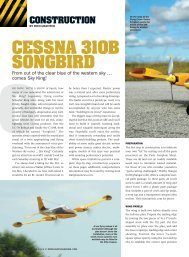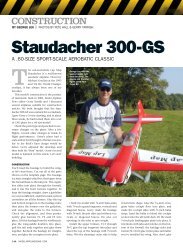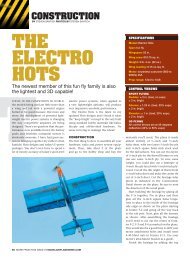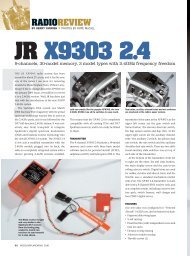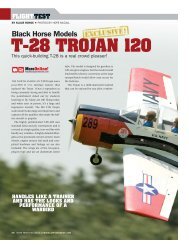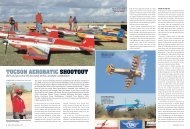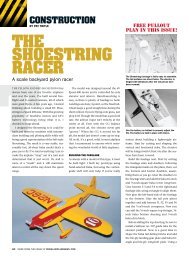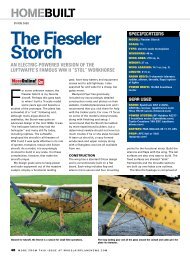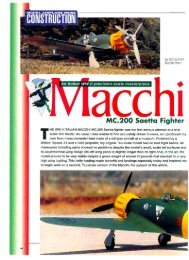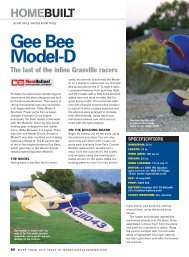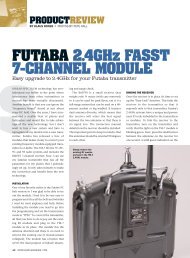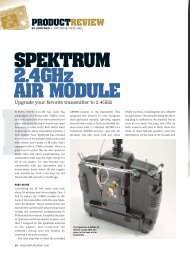Create successful ePaper yourself
Turn your PDF publications into a flip-book with our unique Google optimized e-Paper software.
FINAL APPROACH<br />
BY WILLIAM SIURU<br />
The next-generation UAV<br />
The Predator and Global Hawk unmanned aerial vehicles<br />
(UAVs) are playing key roles in the war on terrorism.<br />
Predators equipped with Hellfire missiles can seek out and<br />
destroy enemy targets. Other Predators fly reconnaissance<br />
missions over Iraq. UAVs are great for high-risk missions because<br />
they don't endanger human pilots, but they fly slow and, thus,<br />
are vulnerable to hostile antiaircraft fire. They also must be flown<br />
by highly<br />
skilled pilots<br />
on the ground. Last, they are<br />
expensive; Predators cost about<br />
$2 million each.<br />
Here, Me<br />
X-Cell 60<br />
RC hellcopter<br />
Is In<br />
flight with<br />
the technologically<br />
advanced<br />
control<br />
system<br />
on board.<br />
With Navy funding, researchers at the Massachusetts Institute<br />
of Technology (MIT) are developing the technology to produce<br />
more maneuverable, more intelligent and less expensive UAVs.<br />
Researchers equipped an X-Cell 60 RC helicopter with a<br />
7-pound instrumentation box containing inertial sensors, a<br />
global positioning (GPS) receiver, an altimeter and a computer.<br />
Flown manually by a trained UAV pilot, the robot helicopter<br />
performed a 360-degree aileron roll at high speed. The maneuver<br />
was recorded, and the information was used to create a<br />
computer simulation from which the researchers developed the<br />
autonomous control software for the helicopter's onboard computer.<br />
The maneuver was then repeated robotically to achieve<br />
the first-ever autonomous acrobatic maneuver with a helicopter.<br />
Researchers are currently working on a split-S—a basic<br />
combat maneuver used by pilots to reverse direction quickly.<br />
The control system works by memorizing the maneuvers<br />
performed by an experienced human pilot and breaking down<br />
the complex pilot inputs into basic mathematical algorithms.<br />
In "building-block" fashion, the computer can then create new,<br />
complex maneuvers just by recombining the various sets of<br />
algorithms. This development makes it possible to program and<br />
fly aggressive maneuvers that may have been previously<br />
unheard of, giving UAVs a decided advantage in a hostile environment.<br />
On a typical mission, a human pilot on the ground<br />
would manually control the UAV through basic maneuvers<br />
such as takeoff and landing, though autonomous takeoff and<br />
landing have already been demonstrated. With a flip of a<br />
switch on the control box, the helicopter would then fly<br />
autonomously.<br />
This new technology presents many possibilities. Small,<br />
agile, robotic helicopters could perform military reconnaissance<br />
154 MODEL AIRPLANE NEWS<br />
Graduate student Loannls Martlnos and<br />
Professor Eric Feron of the Department of<br />
Aeronautics and Astronautics at MIT hold<br />
the robotic helicopter they helped develop.<br />
This Is a block diagram of the<br />
system used to simulate actual<br />
flight maneuvers and develop<br />
computer algorithms.<br />
or carry weapons. They would be particularly attractive for use<br />
in mountainous, urban and other challenging areas that are<br />
currently too dangerous for larger, manned aircraft. They could<br />
fly at low altitude and in tight spaces to locate terrorists in<br />
caves and record live images that could be transmitted to the<br />
ground or to manned aircraft in flight. Civilian versions could<br />
survey disaster sites that are too dangerous for manned operations.<br />
According to the researchers, the technology could, in<br />
the future, yield a 6-inch version able to fly robotically through<br />
an air-conditioning duct, land inside a room and covertly listen<br />
in on a conversation.<br />
The robot helicopter is equipped with vibration-isolation<br />
gear to protect the electronic equipment; this gear could also<br />
keep a camera still, which would give filmmakers a more economical<br />
way to shoot blur-free aerial footage.<br />
The researchers estimate that a military robotic helicopter<br />
with a range of at least several hundred miles would cost<br />
around $500,000. A non-militarized version for filming aerial<br />
imagery would cost significantly less. Though the military is<br />
currently testing unmanned helicopter drones, these would<br />
probably not be in service until after 2006. +



